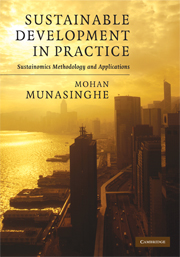Book contents
- Frontmatter
- Contents
- Foreword by James Gustave Speth
- Preface
- Part I Framework and fundamentals
- Part II Global and transnational applications
- Part III National and macroeconomic applications
- Part IV Sub-national sectoral and system applications
- 10 Energy-sector applications
- 11 Transport-sector applications
- 12 Water-resource applications
- 13 Ecological and agricultural system applications
- 14 Resource-pricing-policy applications
- Part V Project and local applications
- References
- Index
10 - Energy-sector applications
Published online by Cambridge University Press: 05 August 2012
- Frontmatter
- Contents
- Foreword by James Gustave Speth
- Preface
- Part I Framework and fundamentals
- Part II Global and transnational applications
- Part III National and macroeconomic applications
- Part IV Sub-national sectoral and system applications
- 10 Energy-sector applications
- 11 Transport-sector applications
- 12 Water-resource applications
- 13 Ecological and agricultural system applications
- 14 Resource-pricing-policy applications
- Part V Project and local applications
- References
- Index
Summary
This chapter applies the sustainomics framework to the energy sector. Section 10.1 reviews energy-development issues and status. In Section 10.2, a comprehensive and integrated framework for sustainable energy development (SED) is developed, which identifies practical sustainable energy options by taking into account multiple actors, multiple criteria, multilevel decision making and many impediments and constraints. A case study of Sri Lanka is presented in Sections 10.3 and 10.4, which illustrates application of the SED approach to electricity planning and renewable energy. Both cost–benefit analysis (CBA) and multicriteria analysis (MCA) are used to show how environmental and social externalities may be incorporated into traditional least-cost power system planning. The study is relatively unique in focusing on assessing such concerns at the system level (including technology choices), instead of the more conventional project-level analysis. Sustainable energy policies for Sri Lanka are identified. Section 10.5 describes an SED application in South Africa, using MCA to assess the social, environmental and economic trade-offs arising from policy options relating to electricity supply and household energy use. Finally, Section 10.6 shows that decentralized energy may be more sustainable than centralized generation options for power system expansion in the UK.
Energy and sustainable development
General background
Sustainable energy development (SED) involves the harnessing of energy resources for human use in a manner that makes development more sustainable. Energy production and use have strong links with the economic, social and environmental dimensions of sustainable development.
- Type
- Chapter
- Information
- Sustainable Development in PracticeSustainomics Methodology and Applications, pp. 313 - 354Publisher: Cambridge University PressPrint publication year: 2009



